(完整word版)新模式英语1Unit6教案.docx
- 格式:docx
- 大小:37.10 KB
- 文档页数:5
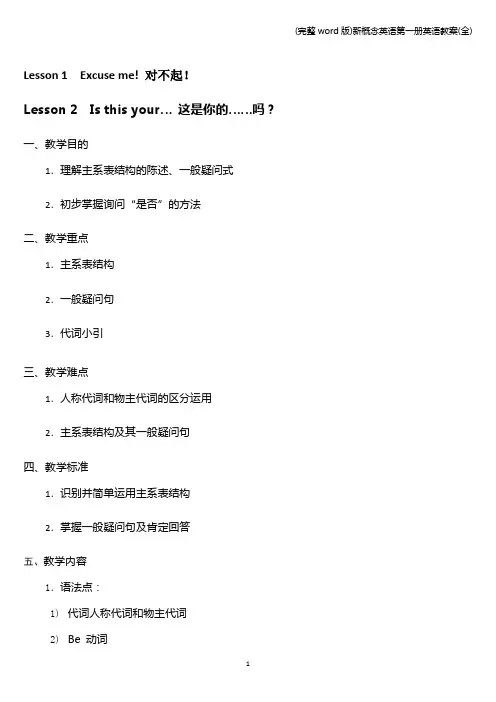
Lesson 1 Excuse me! 对不起!Lesson 2 Is this your…这是你的……吗?一、教学目的1.理解主系表结构的陈述、一般疑问式2.初步掌握询问“是否”的方法二、教学重点1.主系表结构2.一般疑问句3.代词小引三、教学难点1.人称代词和物主代词的区分运用2.主系表结构及其一般疑问句四、教学标准1.识别并简单运用主系表结构2.掌握一般疑问句及肯定回答五、教学内容1.语法点:1)代词人称代词和物主代词2)Be 动词3)一般疑问句4)主系表结构this为主语,名词做表语5)一般疑问句以及它的肯定回答2.语言点:1)打扰他人2)表达谢意3.语音:初步知识,字母、音标介绍六、扩展练习1.打扰他人的表达2.表达谢意Lesson 3 Sorry, sir. 对不起,先生。
Lesson 4 Is this your…这是你的……吗?一、教学目的1.理解并运用主系表结构的陈述、一般疑问式2.掌握询问“是否”的方法二、教学重点1.主系表结构2.一般疑问句3.代词形容词性物主代词三、教学难点1.人称代词和物主代词的区分运用2.主系表结构及其一般疑问句四、教学标准1.识别并简单运用主系表结构2.掌握一般疑问句及否定回答五、教学内容1.语法点:(完整word版)新概念英语第一册英语教案(全)1)否定陈述句2)Be动词的否定形式3)代词的功能4)一般疑问句及否回答5)形容词性物主代词2.语言点:1)询问“是否”2)表达歉意3.语音:字母、音标介绍六、扩展练习1.询问“是否”2.向别人道歉(完整word版)新概念英语第一册英语教案(全)Lesson 5 Nice to meet you 很高兴见到你Lesson 6 What make is it? 它是什么牌子的?一、教学目的1.灵活运用主系表结构2.见面寒暄及介绍第三方二、教学重点1.主系表结构的人称变化2.主系表结构的特殊疑问句三、教学难点1.主系表结构的第三人称2.特殊疑问句的基本结构和回答四、教学标准1.熟练运用主系表结构的陈述式和一般疑问式2.了解特殊疑问句的结构及回答五、教学内容1.语法点:1)主系表结构(主语为第三人称单数)2)冠词a/an 的使用(完整word版)新概念英语第一册英语教案(全)3)特殊疑问句及常用特殊疑问词2.语言点:询问国籍及国籍表达3.语音:辅音爆破音六、扩展练习1.初次见面的问候以及介绍别人2.询问物品的品牌。
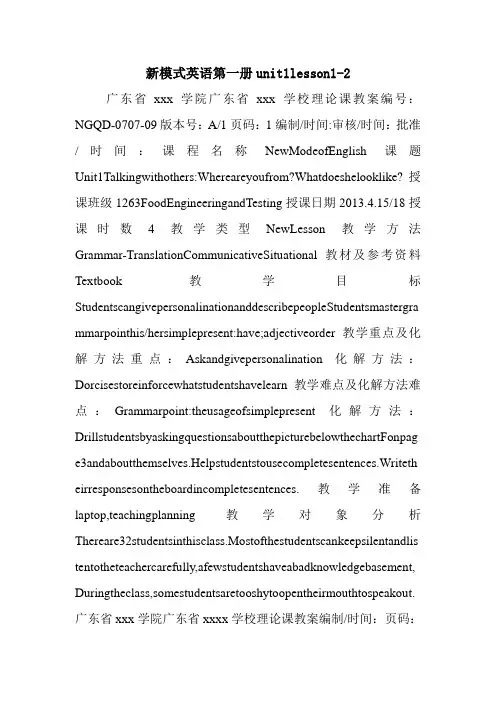
新模式英语第一册unit1lesson1-2广东省xxx学院广东省xxx学校理论课教案编号:NGQD-0707-09版本号:A/1页码:1编制/时间:审核/时间:批准/时间:课程名称NewModeofEnglish课题Unit1Talkingwithothers:Whereareyoufrom?Whatdoeshelooklike?授课班级1263FoodEngineeringandTesting授课日期2013.4.15/18授课时数4教学类型NewLesson教学方法Grammar-TranslationCommunicativeSituational教材及参考资料Textbook教学目标StudentscangivepersonalinationanddescribepeopleStudentsmastergra mmarpointhis/hersimplepresent:have;adjectiveorder教学重点及化解方法重点:Askandgivepersonalination化解方法:Dorcisestoreinforcewhatstudentshavelearn教学难点及化解方法难点:Grammarpoint:theusageofsimplepresent化解方法:DrillstudentsbyaskingquestionsaboutthepicturebelowthechartFonpag e3andaboutthemselves.Helpstudentstousecompletesentences.Writeth eirresponsesontheboardincompletesentences.教学准备laptop,teachingplanning教学对象分析Thereare32studentsinthisclass.Mostofthestudentscankeepsilentandlis tentotheteachercarefully,afewstudentshaveabadknowledgebasement, Duringtheclass,somestudentsaretooshytoopentheirmouthtospeakout.广东省xxx学院广东省xxxx学校理论课教案编制/时间:页码:10教学活动教学流程内容教学手段教师活动学生活动评价方法与评价材料时间分配组织教学anizecount nosesfirstStudentskeepsilentandlistentotheinstructionoftheteacherTi mesheet3mins复习旧课Howtogreetwithyourfriendsandnormalpersonrespectively?askquestio nInterviewthreestudentsAnswerthequestionQuestioningstrategies5mi ns课程导入AskstudentstoopentheirbooksandlookatthepictureofRoberto.Askinati onaboutRoberto.Statetheobjective:Todaywewilllearnhowtogiveperso nalination.Askstudentsquestionslike:Whereishefrom?Ishemarried?H owoldishe?studentsmayormaynotunderstandtheteacher’squestion.Questioningstrategies7mins理论授新LessonOneWhereareyoufrom?A.TalkaboutRoberto.(P1-A&B)B.Lear ethebeverb(P3-F)D.Listeningandrcises(P2-D/G )LessonTwoWhatdoeshelooklike?A.ReviewpersonalinationB.Descri bepeople(P4-A&B)Learnaboutheight,weight,age,hairandeyecolorCo mpleteadriver’slicense.C.Listeningandsimplepresent:have(P5-CDE)D.DescribeHair (P6-G)Grammar-TranslationTheCommunicativeLanguageTeachingC ooperativeLanguageGrammar-TranslationTheCommunicativeLangu ageTeachingCooperativeLanguageOntheboard,write:Whereareyoufrom?Askafewstudentswheretheyarefrom.Exceptone-wordanswer.Poin ttoyourselfandsay:I’mfrom.Dothisactivityasaclass.Makesurethatstudentsunderstandthewo rdssingle,married,anddivorce.Writemartialstatusontheboard.Drillstud entsbyaskingquestionsaboutthepicturebelowthechartFonpage3andab outthemselves.Showstudentswhattolistenforthisfocusedlisteningactiv ity.Remindthemthattheydon’tneedtounderstandeveryword.Askafewstudentswheretheyarefrom.Wr itetheirnamesandprovinceontheboard.GooverFelipe’slicensewiththeclass.Askquestionstocheckforunderstandingandpriork nowledge.Showtheclassyourdriver’slicenseorotheridentification,askstudentswhat’sthedifferencebetweenChina’sdriverlicenseandAmerican’s.SpendsometimehelpingstudentsunderstandtheU.S.systemofmeasure mentandwaystowriteinchesandfeet.showthemafeetis12inches.Thevoc abularyischeckedinthelisteningLearnthewordsabouthairstyleandhave studentstaketurnsdescribingthepeopleStudentsthinkabout20secsormo re,thentheycanresponseornotStudentslookatthepictureandtrytodescrib ebythepersonsonthepictureHavestudentslookatthepicturesinrciseGLis tencarefullyandcompletethemissinginationStudentslistencarefullyand answerteacher’squestionStudentsopentheirbooksandlookatthepicture:Driver’slicenseManystudentswillbefamiliarwiththemetricsystem.studentsch angetheinchandfeetintometer.studentsdescribedriversbycompletingth ederiver’slicense.Studentsusethevocabularytodescribepeople.Studentsmayhav etroublewiththewordageHavestudentsreadthewordsloudlyfollowbyte acherstudentsrespondverballyalkaroundtheclassroomandcheckstuden ts’answersastheywork.verballyjudgementAskstudentstopertheirconvers ationsinfrontoftheclassAskstudentsusehaveorhasdescribepeopleinaco nversationverballyjudgement20mins15mins20mins20mins5mins20m ins20mins10mins30mins教学总结Drillscanbeagoodwaytohelpstudentsbecomefamiliarwithvocabulary,g rammarstructures,andproperpronunciation.Theyalsohelpstudentstoga inconfidence,especiallywhenperingtogetherwiththeirclassmates.Sum marizeSummarizethemainlanguagepoints.Listentotheteachercarefull ystudentskeepsilentandlistencarefully3mins布置作业rcisebookpage1min教学反思1min板书设计LessonOneWhereareyoufrom?1.GivepersonalinationRoberto:Name_ ___Country______Age_____Maritalstatus____Newwords:SingleMa rrieddivorced2.Be(am,is,are)subjectbeinfromationexamplesentenceIa m43yearsoldIam43yearshe,sheissinglefromArgentinaHeissingle./She isfromArgentinaweyoutheyaresingle/married/fromRussiaWearesingle/Youaremarried/TheyarefromRussiaLessonTwoWhatdoeshelooklike ?1.Describepeople:wordsfoot-feetinch-inchespound-poundeg:5’11’’=fivefeet,eleveninches=five-eleven2.SimplePresent:Havesubjectverb examplesentenceI,you,we,theyhaveIhaveblackhair/Youhavewhitehai rhe,she,ithasHehasbrowneyes/Shehasblueeyes3.DescribehairJohn:sh ort/blackMiriam:straight/brownVincent:wave/blondMartha:Curly/gr ayNadia:long/red讲义LessonOneWhereareyoufrom?Goal:GivepersonalinationPartA:Read aboutRobertoRoberto:name,age,country,martialstatus(SingleMarried divorced)WhereisRobertofrom?Ishemarried?Howoldishe?PartB:Gra mmarsubjectbeinfromationexamplesentenceIam43yearsoldIam43yea rshe,sheissinglefromArgentinaHeissingle./SheisfromArgentinaweyo utheyaresingle/married/fromRussiaWearesingle/Youaremarried/They arefromRussiaLessonTwoWhatdoeshelooklike?Goal:Describepeople A.Newwordsfeet&inchafoot=12inchesEg:Heisfivefeet,eleveninchesh air.weight:poundHaircolorandstyleJohn:short/blackMiriam:straight/b rownVincent:wave/blondMartha:Curly/grayNadia:long/redEg:Hehas blackhairandbrowneyes.Miriamhasstraightbrownhair.B.GrammarSi mplePresent:HavesubjectverbexamplesentenceI,you,we,theyhaveIha veblackhair/Youhavewhitehairhe,she,ithasHehasbrowneyes/Shehasbl ueeyesC.Pronunciation/V/D.Summarize。
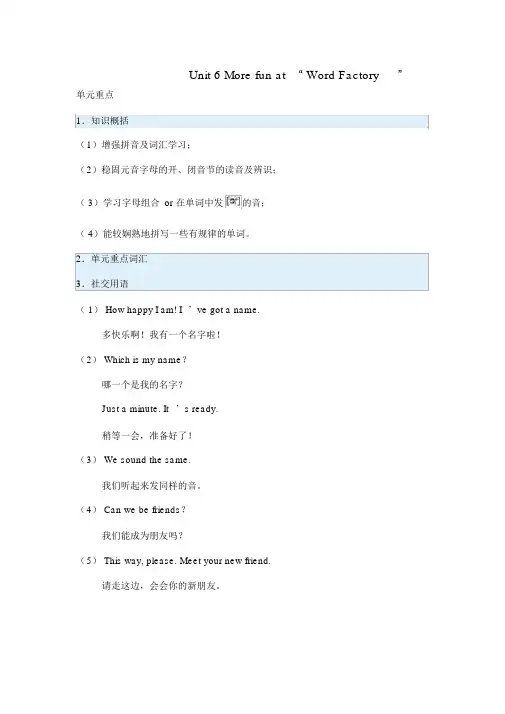
Unit 6 More fun at“ Word Factory”单元重点1.知识概括(1)增强拼音及词汇学习;(2)稳固元音字母的开、闭音节的读音及辨识;( 3)学习字母组合or 在单词中发的音;( 4)能较娴熟地拼写一些有规律的单词。
2.单元重点词汇3.社交用语( 1) How happy I am! I’ve got a name.多快乐啊!我有一个名字啦!(2) Which is my name?哪一个是我的名字?Just a minute. It’s ready.稍等一会,准备好了!(3) We sound the same.我们听起来发同样的音。
(4) Can we be friends?我们能成为朋友吗?(5) This way, please. Meet your new friend.请走这边,会会你的新朋友。
Period 1 —Period 21.复习(1) Words and expressions:(2) Sentences:Please look carefully and write their names in the boxes.请认真察看,把它们的名字写在盒子里。
I can write“ T”.我能写“T。
”You want it. You say it and then you get it.你要它,你说它而后你就能获得它。
Aa is for an apple.Aa 代表一个苹果。
(3) Pronunciation:字母组合 ir 在重读音节中发的音,发时嘴型扁平,上下齿轻轻张开,舌身放平,舌中部轻轻抬起。
2.重难点知识解说①Words and expressions:②Bee: How happy I am! I’ ve got a name.多快乐啊!我有一个名字啦!Plane:Which is my name?哪一个是我的名字?Bird :Just a minute. It’ s ready.稍等一会,准备好了!Worker: Oh, another bad name.噢!又一个错误名!③Same family word. This way, please.同一家庭单词,请往这边走。
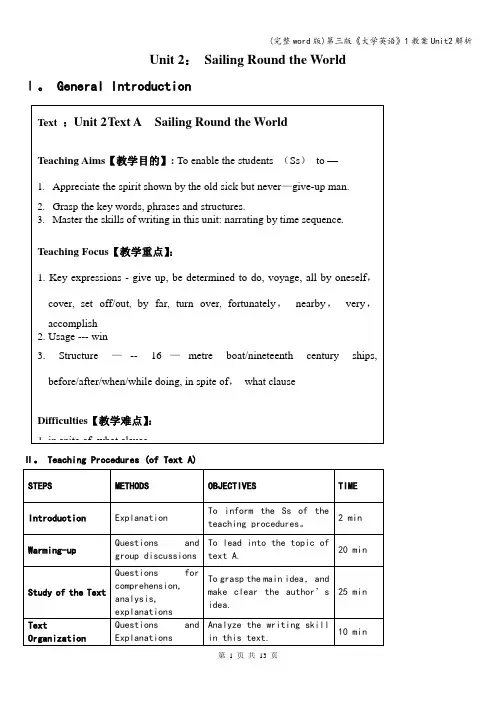
Unit 2:Sailing Round the World Ⅰ。
General IntroductionⅡ。
Teaching Procedures (of Text A)Ⅲ。
Detailed Teaching ActivitiesSTEP 1 — Introductory RemarksA British adventurer, Francis Chichester traveled round the world alone in a small boat called the “Gipsy Moth IV” in spite of the fact that he had lung cancer. This text tells us briefly what happened to him on his voyage。
To begin with, let’s draw a map of Chiceester’s course.STEP 2 - Warming-up1. DiscussionTeacher: Before we study the text, let me ask you some questions.1) Do you like traveling? Do you like traveling alone?2) What do you think is the most important for a person who suffer from lung?2. Questions about the TextBased on the title, guess what the text is about。
Question: Who sailed round the world, and how?3。
Information Related to the Text1) Sir Francis ChichesterBorn in Devon, Britain, in 1901, Sir Francis Chichester later became a British adventurer. As a young man, he went to New Zealand, where he worked as a miner, salesman and land agent。
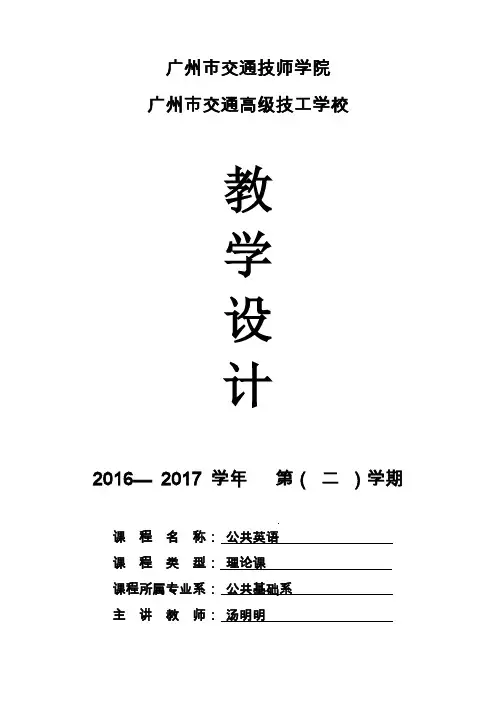
广州市交通技师学院
广州市交通高级技工学校
教
学
设
计
2016—2017 学年第(二)学期
课程名称:公共英语
课程类型:理论课
课程所属专业系:公共基础系
***师:***
广州市交通技师学院广州市交通高级技工学校教学设计(首页)(代号A-3)
教学实施过程(代号A-4)
广州市交通技师学院广州市交通高级技工学校教学设计(首页)(代号A-3)
教学实施过程(代号A-4)
广州市交通技师学院广州市交通高级技工学校教学设计(首页)(代号A-3)
教学实施过程(代号A-4)
广州市交通技师学院广州市交通高级技工学校教学设计(首页)(代号A-3)
教学实施过程(代号A-4)。
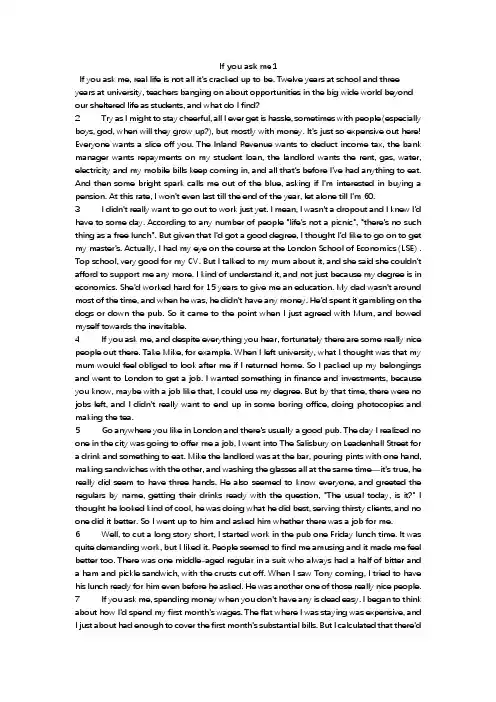
If you ask me1If you ask me, real life is not all it's cracked up to be. Twelve years at school and three years at university, teachers banging on about opportunities in the big wide world beyond our sheltered life as students, and what do I find?2 Try as I might to stay cheerful, all I ever get is hassle, sometimes with people (especially boys, god, when will they grow up?), but mostly with money. It's just so expensive out here! Everyone wants a slice off you. The Inland Revenue wants to deduct income tax, the bank manager wants repayments on my student loan, the landlord wants the rent, gas, water, electricity and my mobile bills keep coming in, and all that's before I've had anything to eat. And then some bright spark calls me out of the blue, asking if I'm interested in buying a pension. At this rate, I won't even last till the end of the year, let alone till I'm 60.3 I didn't really want to go out to work just yet. I mean, I wasn't a dropout and I knew I'd have to some day. According to any number of people "life's not a picnic", "there's no such thing as a free lunch". But given that I'd got a good degree, I thought I'd like to go on to get my master's. Actually, I had my eye on the course at the London School of Economics (LSE) . Top school, very good for my CV. But I talked to my mum about it, and she said she couldn't afford to support me any more. I kind of understand it, and not just because my degree is in economics. She'd worked hard for 15 years to give me an education. My dad wasn't around most of the time, and when he was, he didn't have any money. He'd spent it gambling on the dogs or down the pub. So it came to the point when I just agreed with Mum, and bowed myself towards the inevitable.4 If you ask me, and despite everything you hear, fortunately there are some really nice people out there. Take Mike, for example. When I left university, what I thought was that my mum would feel obliged to look after me if I returned home. So I packed up my belongings and went to London to get a job. I wanted something in finance and investments, because you know, maybe with a job like that, I could use my degree. But by that time, there were no jobs left, and I didn't really want to end up in some boring office, doing photocopies and making the tea.5 Go anywhere you like in London and there's usually a good pub. The day I realized no one in the city was going to offer me a job, I went into The Salisbury on Leadenhall Street for a drink and something to eat. Mike the landlord was at the bar, pouring pints with one hand, making sandwiches with the other, and washing the glasses all at the same time—it's true, he really did seem to have three hands. He also seemed to know everyone, and greeted the regulars by name, getting their drinks ready with the question, "The usual today, is it?" I thought he looked kind of cool, he was doing what he did best, serving thirsty clients, and no one did it better. So I went up to him and asked him whether there was a job for me.6 Well, to cut a long story short, I started work in the pub one Friday lunch time. It was quite demanding work, but I liked it. People seemed to find me amusing and it made me feel better too. There was one middle-aged regular in a suit who always had a half of bitter and a ham and pickle sandwich, with the crusts cut off. When I saw Tony coming, I tried to have his lunch ready for him even before he asked. He was another one of those really nice people.7 If you ask me, spending money when you don't have any is dead easy. I began to think about how I'd spend my first month's wages. The flat where I was staying was expensive, and I just about had enough to cover the first month's substantial bills. But I calculated that there'dbe just enough money over to treat myself to something. Why not get a CD or maybe a plant to cheer up the flat? I thought.8 It was my birthday on pay day. Apart from Mike and Tony, I didn't have any friends in London. Seeing that I didn't have a boyfriend either, you can understand why I began to feel sorry for myself. So I ordered myself some flowers, and asked them to be sent with a little card, saying "With all my love Anon." The highlight of my birthday would be the confused look on the florist's eyes when he delivered them.9 Later that week, Tony came in as usual and sat down at the bar. "What's wrong with you? Where's that smile gone today?" I talked to him about... well, about pretty well everything, money, the master's, my birthday, the lot. He sympathized with me.10 Tony got up from his stool, and went over to talk to some of the others. Remember: The Salisbury is right in the heart of the city, so all the customers were in banking or insurance or the stock market. Next day he turned up with cheques to the value of £20,000. "This is a loan for you to set up your business. The only collateral you have is my trust in you that one day, you'll pay us back—if you can. And if you can't, too bad, that's the finance business for you. But I think you will."11 I didn't say anything for fear that I was going to cry. What were the odds on anyone being so nice?12 And the flowers? I redirected them to my mum, and they arrived for her on my birthday. She deserved them, don't you think?13 If you ask me, looking back after all these years, you only need one or two breaks in your life to succeed. The fact that the rest is hard work doesn't matter, it's still worth it.14 After a year working at The Salisbury, I got a place at the LSE, did my master's and found a job in an investment bank. I in vested the £20,000, and sold out before the 2008 crash.I paid back Tony and the other investors, with ten per cent annual interest, and set up my own firm. It exceeded all my expectations and is still a thriving business.15 Tony wrote me a thank-you note. He'd been in a car accident, and couldn't walk. The money I paid back would allow him to adapt his house so he could move around it in his wheelchair. This is what he wrote:16 "Thirty-five years in banking, and I've never made a better investment than the loan to you. You've repaid the money with interest, and my trust in you and your honesty 100-fold. If you ask me, investing in people gives the best return you can ever hope for."17 If you ask me, he's right. What do you think?依我看依我看,现实生活并没有人们想象的那么好。
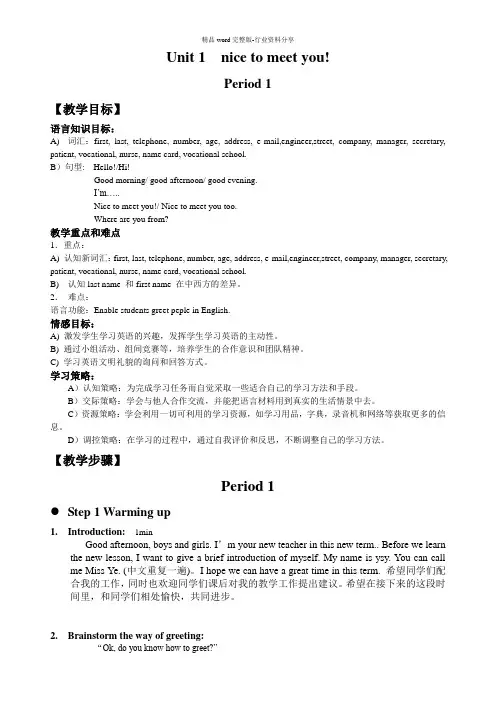
Unit 1 nice to meet you!Period 1【教学目标】语言知识目标:A) 词汇:first, last, telephone, number, age, address, e-mail,engineer,street, company, manager, secretary, patient, vocational, nurse, name card, vocational school.B)句型: Hello!/Hi!Good morning/ good afternoon/ good evening.I’m…..Nice to meet you!/ Nice to meet you too.Where are you from?教学重点和难点1.重点:A) 认知新词汇:first, last, telephone, number, age, address, e-mail,engineer,street, company, manager, secretary, patient, vocational, nurse, name card, vocational school.B) 认知last name 和first name 在中西方的差异。
2.难点:语言功能:Enable students greet peple in English.情感目标:A) 激发学生学习英语的兴趣,发挥学生学习英语的主动性。
B) 通过小组活动、组间竞赛等,培养学生的合作意识和团队精神。
C) 学习英语文明礼貌的询问和回答方式。
学习策略:A)认知策略:为完成学习任务而自觉采取一些适合自己的学习方法和手段。
B)交际策略:学会与他人合作交流,并能把语言材料用到真实的生活情景中去。
C)资源策略:学会利用一切可利用的学习资源,如学习用品,字典,录音机和网络等获取更多的信息。
D)调控策略:在学习的过程中,通过自我评价和反思,不断调整自己的学习方法。
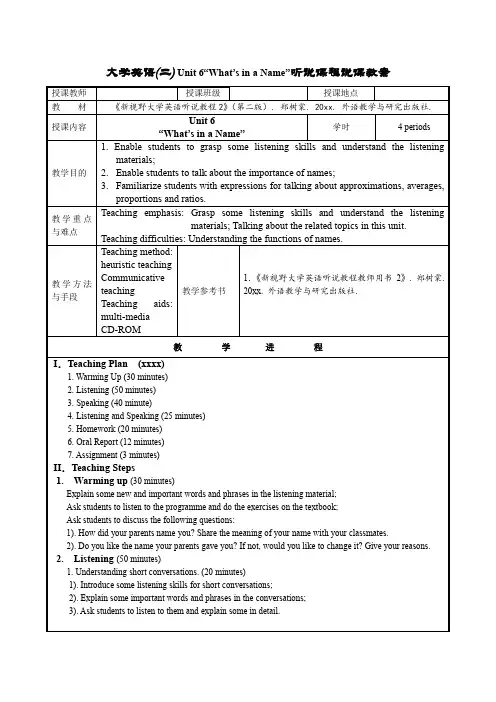

T: The Sydney Opera House is the most famous place in Sydney. It’s a cultural centre for concerts, dramas and operas.3. Team workS1: The kangaroo is a large animal. It’s brown. It has a small head and a big body. Its front legs are short. Its back legs are long and strong. It can jump far and high. I t has a long tail.S2: The koala is small. It’s grey. It has large ears. It has no tail. It lives in trees and eats leaves.4. Introduction the Sydney Opera House5. Free talkHow did you find out about Australia?Did you go to the library?Did you search on the Internet?Do you have a friend or a relative in Australia?6. Read the textWho? Where?Where is Liu Tao?What is Liu Tao doing?What does the article talk about?Do you think Australia is an interesting country?Step 3 Practice1. reading2. retell the textT: How will Mike find out about Australia?S1: He’ll ask his e-friend in Australia. T: What about Wang Bing?S2: He’ll ask Mr Green. He comes from Australia. T: What about Liu Tao?S3: He’ll read about Australia on the Internet. T: How about Yang Ling?S4: She’ll go to the library and look for books and magazines about Australia. 3. Team work2. 拓展活动(I’m a tour guide)Step 4 Homework1.听录音熟练朗读story time2.小组内表演故事板书设计Unit6 An interesting countrykangaroo, koala, Australian football, SydneyHow can they know about Australia?What does he know ?。
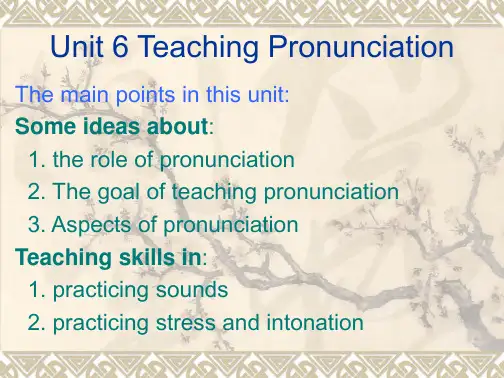
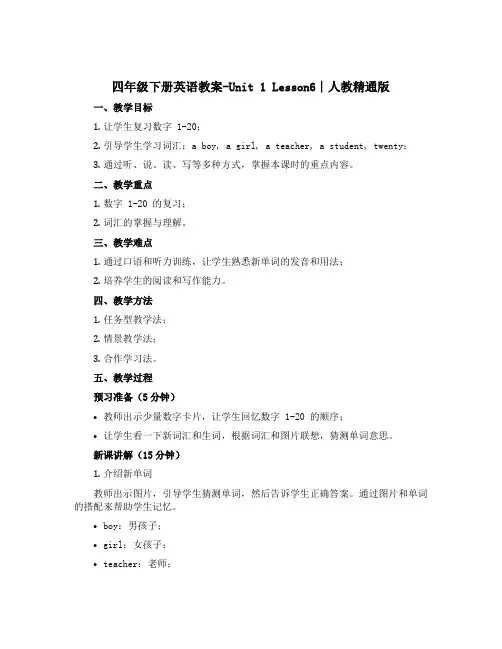
四年级下册英语教案-Unit 1 Lesson6∣人教精通版一、教学目标1.让学生复习数字 1-20;2.引导学生学习词汇:a boy, a girl, a teacher, a student, twenty;3.通过听、说、读、写等多种方式,掌握本课时的重点内容。
二、教学重点1.数字 1-20 的复习;2.词汇的掌握与理解。
三、教学难点1.通过口语和听力训练,让学生熟悉新单词的发音和用法;2.培养学生的阅读和写作能力。
四、教学方法1.任务型教学法;2.情景教学法;3.合作学习法。
五、教学过程预习准备(5分钟)•教师出示少量数字卡片,让学生回忆数字 1-20 的顺序;•让学生看一下新词汇和生词,根据词汇和图片联想,猜测单词意思。
新课讲解(15分钟)1.介绍新单词教师出示图片,引导学生猜测单词,然后告诉学生正确答案。
通过图片和单词的搭配来帮助学生记忆。
•boy:男孩子;•girl:女孩子;•teacher:老师;•student:学生;•twenty:二十。
2.数字 1-20 复习教师可通过让学生数数、唱歌等方式来复习数字 1-20。
3.看图说词教师出示图片,让学生描述图片中的人物和物品,引导学生说出相应的单词。
练习(25分钟)1.听音识词播放录音,让学生听录音,然后说出录音中出现的单词。
教师要引导学生注意发音,并告诉学生错别字的正确写法。
2.学生讲解学习方法学生自己讲解学习方法,如何记忆新单词,如何练习口语等,让学生尝试独立思考和总结。
3.合作学习学生分为小组,互相搭配,进行合作学习。
学生可以一起练习口语,或者通过练习写作来巩固所学内容。
总结(5分钟)教师让学生用自己的语言总结一下本课所学的内容。
六、教学反思本课使用了多种教学方法,引导学生通过不同的方式来学习单词和数字。
特别是在合作学习环节,学生的口语和写作能力得到了较大的提升。
但是需要注意的是,有些学生记忆能力薄弱,需要耐心引导和帮助。
Unit 1 FriendshipWarming up1.be good tobe good for=do good tobe good at2.following adj. 下面的,下列的the following+n.=the+n.+below ( 形容词修饰名词放在名词之前,介词或者介词短语修饰名词置于其后)3. add v. add...to...add toadd upadd up toaddition n.in addition=besides +句子in addition to +n./doing 同类用法联想: because & because ofinstead & instead of “而且,其次”“附加给 ..., 除了 ...还有 ...”additional adj. 附加的additionally adv.4. 分数 score grade point mark (full marks)5. until6. with 和...一起,附带着,用without 不...within在...内,不出 ...E.g. write with a peneat with hands/ spoon/chopsticks/knife and forkHe left without saying goodbye.He left with the water running.分析: saying 前无名词,则是主语发出 saying 的动作; running 前有 water,因此是 water 发出 running 的动作,而不是句子的主语 he。
翻译练习:(1)他今天去上班没带领带。
Today, he went to work without (wearing) his tie.(2)他在没有其他人帮助的情况下自己完成了作业。
7.pay for payto do sth8. get sb to do sth(make/have/let sb do sth)get sb/sth doneget done get lost/prepared/dressed/involved9.形容词做状语,表示句子主语的特征、属性和状态副词做状语,表示谓语动词的完成方式E.g. He returned home last night, sad and disappointed.He left hurriedly.10. concern n. 担心,忧虑concern about/for/over...E.g. She hasn’ t been seen for four days and there is concern for her safety.That is a big concern.v. 涉及,与 ...有关be concerned withconcerning E.g. He asked several questions concerning the future of the company.翻译练习:不要问女人们涉及她们年龄的问题。
NCE 2A Unit1 Linda comes to London辅导讲义Part1:知识清单:四会单词Vocabulary1.ex____t 出口:Linda is next to the Arrivals exit.2.st__ ___d 站立:Paul is standing beside Karen.3。
su___tc___s___ 手提箱,皮箱:I have got my suitcase。
4.ph___ ___ ____ 电话:I am giving him my phone now。
5。
s____t 坐:She is sitting in her armchair.三会单词Vocabularysandwich 三明治armchair 扶手椅stand up 起立,站起来read 读TV电视listen to 听next to 紧靠.。
.旁边,wait for 等待come round 来到附近重点知识点Key Points现在分词的构成规则:1. 一般动词直接加-ing do-— doing;go-going。
2。
以辅音字母+ e 结尾的动词,去e 加-ing。
make-making; take—taking3. 以ie结尾的动词,把ie改成y, 再加—ing。
lie—lying;die-—dying4。
以重读闭音节为末尾音节,且以单个辅音。
5. 字母结尾的动词,将词尾辅音字母双写,再加—ing run—running; sit--sitting7。
以重度-r音节为末尾音节的动词,双写r,再加—ing prefer—preferring; refer—referring1.现在进行时:正在做什么动作或者是正在发生什事情。
2.形式:be动词(am ,is ,are)+动词ing语法点Grammer:仔细观察下面例子哦~陈述句:He is drinking coffee。
否定句:He is not drinking coffee。
新模式英语1 Unit6教案___.2. Have a group n ___.Ⅱ. n教学内容师生活动通过PPT或视频教学展示各部位的单词和句型,并进行模仿和练1. Use PPT or videos to present new ___Ⅲ. Practice教学内容师生活动通过角色扮演和问答练,让学生在实践中掌握所学内容1. Practice through ___ to help students apply what they have learned.Ⅳ. n教学内容师生活动通过游戏、歌曲等扩展活动,巩固所学知识并激发学生研究兴趣1. Use games, songs, ___.板书设计Lesson 1 Parts of the bodyNew Words:- Head, eyes, ears, nose, mouth, teeth- Neck, shoulder, back, arm, hand, finger, stomach- Bottom, leg, knee, foot, toeSentence Patterns:- What’s the problem?- ___.1. ___ are created using body parts. This will ___.2. Write "Parts of the Body" on the board to introduce the topic.n:1. ___ to the students, ___.2. Divide the students into three groups and ask them to write down the body parts they have learned before. Each group should focus on a different part of the body (head, middle, lower).Teaching the Body Words:1. For the top part of the body (head, eyes, ears, mouth, nose), ___ and ask students to use the sentence pattern "He/She/It has" to describe the character's most distinctive body part.2. Ask students to fill in the blanks using the body parts they have learned, e.g. "We see with _____," "We listen with _____," etc.3. For the middle part of the body (neck, shoulder, back, arm, hand, finger, stomach), use visuals and examples to help students understand the ___ of each body part.different cultural backgroundsExplain to students that body language can have different meanings in different cultures. Share a story or example to ___.5. Extend the lesson___ phrases and body language requires more than just looking at the literal meaning of the words. Encourage them to apply this ___.6. Read a short article with ns4. ___。
(此文档为word格式,下载后您可任意编辑修改!)
课时计划
课时计划年 9 月 6 日
课时计划年 9 月 7 日
课时计划年 9 月 10 日
课时计划年 9 月 9 日
课时计划年 9 月 11 日
课时计划年 9 月 15 日
课时计划年 9 月 16 日
课时计划年 9 月2 1 日
课时计划年 9 月 24 日
课时计划年 9 月 26 日
课时计划年 9 月 27 日
9月28 日做能力培养,以及改错。
10月8日整理一至三模块的知识网络梳理,以及检测重难点知识
课后反思:通过练习,学生们的综合语言运用能力有长进,变换句子结构还有代进行训练。
课时计划年 10 月 11 日
课时计划年 10 月 12 日
课时计划年 10 月 15 日
课时计划年 10 月 18 日
10月19日做课堂练习
10月22日做能力培养
课后反思;通过各种形式练习,教师对本课进行说的能力的培养和训练,达到较好的效果,对划线提问方面的练习还需进一步提高。
课时计划年 10 月19 日
课时计划年 10 月 22 日
课时计划年 10 月 25 日
10、26新课程能力培养
变换词性答得不是很好,需要加强这方面的练习,其他题型学生普遍答得较好。
本模块主要知识点掌握较好。
10、29月考当堂检测
详见卷子。
课时计划年 10 月 29 日
11、1做新课程能力培养
课时计划年 11 月 5 日。
教案首页授课日期班级课题: Unit 6 Lesson 1 Parts of the body教学目的要求: 1. Students can read and identify the words of body parts2. Students can ask and answer :What is theproblem? My leg/hand ⋯ hurt(s)3.Students can talk to the doctor about their body problems教学重点: Students can understand the instructions and do the right reactions topoint out body parts教学难点: Ss will be able to use the sentence patterns to talk about their bodyproblems授课方法:授法,小法、交法、任型教学法教学参考及教具(含多媒体教学设备):《新模式英1》、黑板、粉笔PPT、卡、。
授课执行情况及分析:板书设计或授课提纲Lesson 1 Parts of the bodyⅠ. New Words1.The top part of the body: head, eyes, ears, nose, mouth, teeth2.The middle part of the body: neck, shoulder, back, arm, hand, finger, stomach3.The last part of the body: bottom, leg, knee, foot, toeⅡ. Sentence PatternsA:What ’ s the problem?B:My leg hurts./ My feet hurt.教学环节教学内容师生活动Ⅰ. Lead-in 1.Play a guessing gameAsk Ss to guess what the logo stand for 启(发学生回答这些知名的 logo 都是由肢体摆成的,让学生猜出本节课所讲内容)2.Write Parts“ of the body” on the board.3.State the objective: We’ ll say our body parts and talk to the doctor about body problems today. 通过让学生猜一些用身体摆成的 logo 导入课题,老师板书Ⅱ.PresentationA 1.Explain the teaching aims to students(向学生逐条解释学习目标)2.Group discussion(1)Divide the Ss into three groups, ask them towrite down the body parts which they have learnedbefore.(第一组写出与头部有关的单词,第二组写身体中间部分的单词,第三组写下半身的单词 )(2)Each group choose two students to report, oneread the word , the other student write the words onthe blackboard.(3)The teacher to supplement3. Teach the body words in different ways.(1)The top part of the body: head, eyes, ears,mouth and nose. a.出示一些卡通人物的图片让学生用 He/She/It has 这个句型来描述人物最有特点的身体部位。
b. Ask Ss to use these body parts to fill in theblanks e.g: We see with _______小组讨论,集思广益写下他们以前学过的身体部位的单词。
给学生展示各部位的图片,通过回答问题、指认身体部位以及拼写单词各种方式学习新单词We listen with ______We smell with_______We eat with _______(2)The middle part of the body: neck, shoulder,back,arm, hand, finger,stomach(Ask Ss to read aloud,while they ’ re reading ask themto point these body parts)(3)The last part of the body: bottom, leg, knee, footand toe (Ask Ss to look at the pictures and then spellthe words in the correct order)(4) T shows the flash cards, asks Ss to say the wordsas quickly as they can(老师出示单词闪卡让学生迅速读出卡上的单词)教学环节教学内容师生活动(4) Label Xue Zhiqian ’ s body(parts请三位同学在PPT 上标注出薛之谦的身体部位名称,其余同学在纸上标注)III. Practice A 1. Enjoy body song: If you are happyWhile listening ask students to find out how manyactions are mentioned in the song and what they are.2. Teach some phrases:clap your hands拍拍手stomp your feet跺跺脚nod your head点点头touch your neck摸摸脖子shrug your shoulder 耸耸肩raise your arm举起胳膊shake your hand摆摆手snap your finger打响手指3. Play a game 同桌互批让学生听歌曲回答问题老师做动作帮助学生理解这短语的中文含义Ask one student read the phrases and the others to do两人一组游戏the action.4.Share a story which is about the body langue with通过一个小故事讲解一Ss,then ask Ss if the same action has the same些体态语在不同文化背meaning in different countries.景下的差异IV .Extension Give some phrases about body, ask students to guessA meaning of the phrases.1. the apple of one's eye 掌上明珠2. An eye for an eye, tooth for a tooth以眼还眼,以牙还牙3.Walls have ears隔墙有耳4.be all ears.洗耳恭听5.a fresh hand新手6.Two heads are better than one head.三个臭皮匠顶个诸葛亮( 先单独出示短语让学生猜,然后给出一定的语境帮助他们猜)对所学知识进行扩展,提醒学生理解短语的意思不能只看字面的含义,活学活用。
Ⅴ.PresentationB 1. Ask and answer :If your body is ill, what problemswill happen?2.Give Ss 1miute to read Victor ’s talk to thedoctor and learn his problems.3.T explain the meaning of “hurt”to Ss, and ask Ssthe differences between hurt and hurts. (让学生思考为什么文中的句子有时候用 hurt 有时候用 hurts)让学生带着问题阅读短文教学环节教学内容师生活动Ⅵ.Practice B 1. Ask Ss to fill in the blanks.My feet _____ .His front tooth ______.I ____my fingers when I cut the meat yesterday2.Ask Ss to find out what the doctor says and whatVictor says in the passage,then make up a dialogue.3.学生接A: What ’s the problem?B: My ⋯hurt/hurts. 让学生完成练习,让学生自己讲出填写答案的理由让两位同学朗读他们编好的对话。
Ⅶ . Extension 1. Teach some other useful expressions between the B doctor and the patient病情:⑴ What’ wrong ( with you )?⑵ What’s the matter ( with ) you ?(3) What’ s the trouble?回答:⑴ I ’m not feeling well .⑵ I don ’t feel well .⑶ I ’m not myself .⑷ I feel terrible .2. Show the model on PPTDoctor: Hello, What’ syour problem?(你怎么了?)Victor: Doctor, I am very sick.Doctor: You don’ t look very well(看.上去气色不太好)Victor: My legs hurt and my back hurts.Doctor: I will give you a checkup(你做一个) and see what the problem is.Victor: Ok, thanks.2. Ask Ss to make up their own dialogues and act it out in front of class.出示对话模板,要求学生两人一组编写自己的对话并且上台表演。